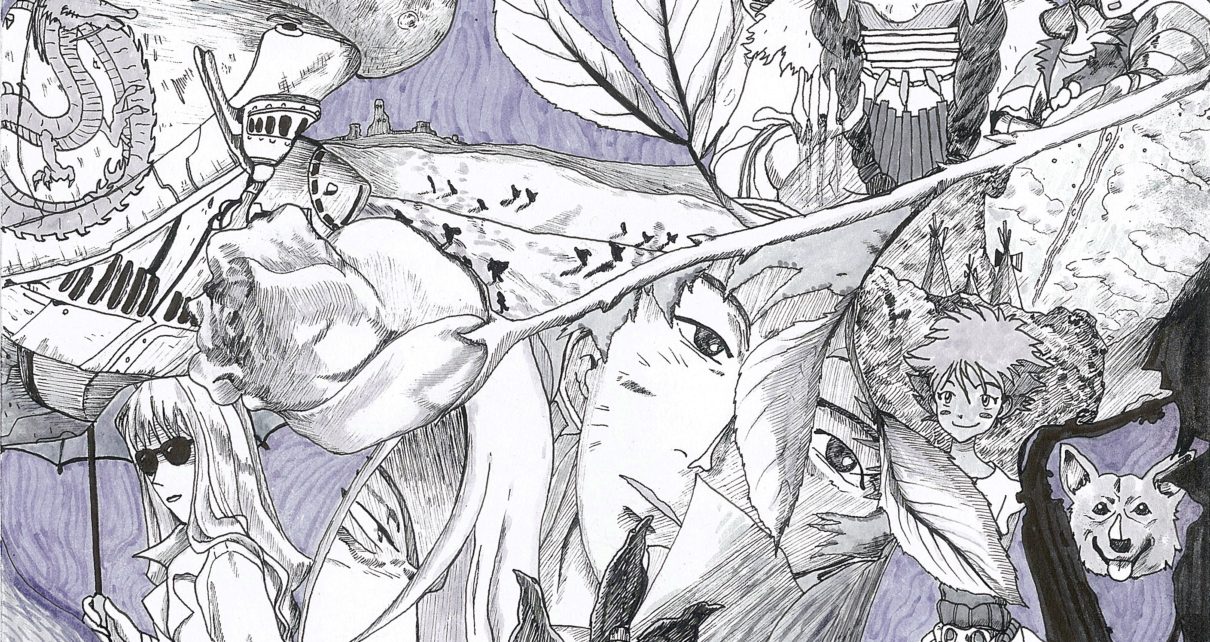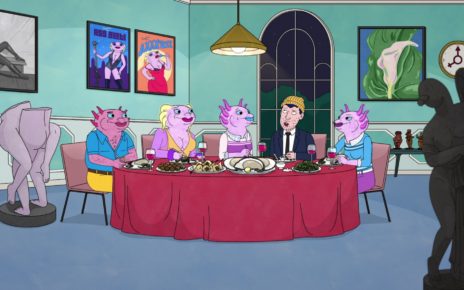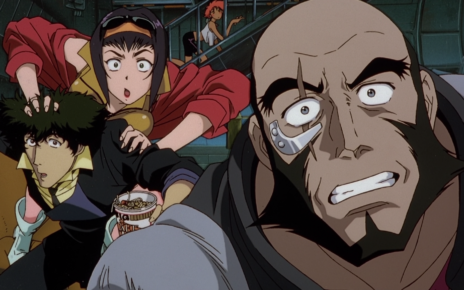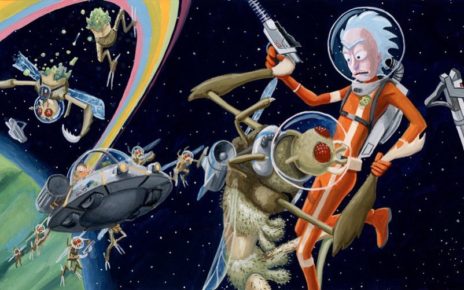3…2…1…Let’s Jam
[Top art by Wyatt Erchak]
Way back in 1998, when people were worrying about, like, Y2K and a competent yet philandering president and not, say, nuclear war with North Korea and an incompetent, philandering, quite possibly traitorous president (sigh), a 26-episode animated television show about bounty hunters in space was released in Japan. In 2018, it is justly considered to rank near the top of the greatest works in anime history. For the next month or so, we’ll be dedicating our site to showing exactly why that is. Welcome to Space Cowboy Serenade, The Dot and Line’s month-long package celebrating 20 years of Cowboy Bebop.

Why It Matters
As a show, Cowboy Bebop has it all. Gorgeous animation. Seamless CGI integration. Compelling characters with shadowy yet rewarding backstories who just ooze cool. Paeans to cinematic genres ranging from noir to Western to Hong Kong action movie to monster flick. Tragic romance and slapstick humor. Crime syndicates and space cowboys. An animal companion that actually adds nuance and humor. Terrific pacing. A universe that feels lived-in without info-dumped world-building. And a soundtrack so consistently brilliant it’s worth a listen on its own. Oh, yeah, and a comprehensive and convincing philosophy, too.
Beyond that, there’s its sheer influence. It’s hard to watch contemporary sci-fi anime and not see Bebop’s imprints. Hell, it’s hard to watch space opera at all and not see Bebop’s influence. (Joss Whedon, may the gods curse him, basically ripped this series off wholesale for Firefly.) This is all the more remarkable considering that the show itself is such a pastiche it almost borders on parodic, filled with references to cultural touchstones from Star Trek to Kareem Abdul-Jabbar and entirely reliant on cinematic languages pioneered by the likes of Billy Wilder, Robert Rodriguez, Akira Kurosawa, Ridley Scott, and John Carpenter. Its director, Shinichirō Watanabe, created a tagline billing it as “a new genre unto itself.” That is simultaneously an utter lie—it’s indebted to everything—and an absolute truth: there is nothing quite like it. It is often called a gateway drug to the entire anime medium, if not one of anime’s greatest achievements outside of Akira and the works of Hayao Miyazaki. Those who call it that would not be wrong.
Why We Care
Real talk: we two big blasting bop boys who run this site, Eric and John, have been obsessed with this show since our youth, ever since it aired on Adult Swim three years after its Japanese debut. We have friends who have 4-foot-long silk-screened posters from this show on their walls. We have watched this show in full more than 10 times each and have probably collectively put more hours into watching the first five episodes with friends we were hoping to convert to it than we have playing The Legend of Zelda: Breath of the Wild (which, for the record, is a lot). We are getting themed tattoos after this madness of a month (sorry, March) is over. It would not be a stretch to say that Cowboy Bebop, with its razor-sharp writing and mature themes, sustained our childhood love of cartoons as we edged reluctantly into adulthood. We have freaked out over it. We have cried to it. We adore this show.
We also, admittedly, really wanted an excuse to salute it. We just…might have gone a bit overboard.
Why We Used the Dub
If you’re a big anime fan, chances are you stick religiously to the subtitled, original Japanese iterations of most animes, probably because you know that many dubs suck! That said, if you’re a big anime fan, you know that this dub is considered perhaps the best in all of anime history. We grew up on this dub, and our audience is primarily (if not exclusively) English-speaking, so for this package, we went with the dub. We figure you’ll be fine with that.
What We’ll Deliver
For the next five weeks, expect at least six stories a week. Expect full coverage of every episode of Cowboy Bebop, and of its soundtrack, and of its feature-length film, Knockin’ on Heaven’s Door, thanks to the tireless efforts of some of our dearest friends and best and most dedicated writers. Expect fun GIFs from the show to be shared on our social channels, courtesy of our terrific social media editor, Elly Belle. Expect interviews and podcasts, reviews and love letters, poems and personal pieces. Expect all Cowboy Bebop, all the time. Expect the solar system. We aim to give it.
Just don’t expect any bell peppers and beef. We have too much else cooking.
So come one, come all, to Space Cowboy Serenade. And buckle on up there, buckaroos. It’s gonna be a wild ride, if Spike, Jet, Faye, Ed, and Ein have anything to say about it.

The Stories
Here are all the stories we’ve published this month:
Session 01: An interview with Jason DeMarco of Adult Swim and Cartoon Network, breaking down how the show came to the US.
How ‘Cowboy Bebop’ Came to the States: An Exclusive Interview for Its 20th Anniversary
Behind the Music: An analysis of the iconic opening theme of Cowboy Bebop, “Tank!” by Alex Costello.
Let’s Jam: The Glorious Explosion That Is Cowboy Bebop’s Opening Theme
Session 02: A look at “Stray Dog Strut” and Bebop’s beloved corgi, Ein, by Charlotte Dow.
How a Cartoon Corgi Hooked Me on ‘Cowboy Bebop’
Session 03: An analysis of Faye Valentine and how Bebop handled the issue of her debt, by talia jane.
Faye’s Debts Made Her One of the Most Human Characters on ‘Bebop’
Session 04: A close read on the last third of the episode “Gateway Shuffle,” by Eric Vilas-Boas.
In Defense of “Gateway Shuffle”—The Lamest Entry of ‘Bebop’
Session 05: What you will learn from watching “Ballad of Fallen Angels” — and nothing else — a million times, by Katie Bohri.
I Watched “Ballad of Fallen Angels” and Have So Many Questions
Session 06: Inside the world-building and blues of “Sympathy for the Devil,” by John Maher
At Least He Could Wail on the Harmonica
Session 07: For a metalhead, “Heavy Metal Queen” proved to be the perfect intro to Bebop, wrote Joey Cosco.
I Watched Cowboy Bebop for the First Time and Now Everything Makes Sense
Session 08: Two poems that dig deep into the queerness and the pain of “Waltz for Venus,” by Trevor Dane Ketner.
Two Poems on “Waltz for Venus,” One of the Most Poignant Episodes of ‘Bebop’
Session 09: A peek at how Bebop introduced Ed and illustrated its dystopia in “Jammin’ With Edward,” by Marley Crusch.
How Cowboy Bebop Pulled Off Its Believable Dystopia
Sessions 10, 16, 21: A breakdown of the ego and the masculinity of Jet Black in “Ganymede Elegy,” “Black Dog Serenade,” and “Boogie Woogie Feng Shui,” by Eric Vilas-Boas.
Why Jet Black’s Fragile Male Ego Is the Key to His Character
The Movie: A spoiler-free explainer to enjoying Cowboy Bebop: The Movie—aka “Knockin’ on Heaven’s Door”—by Amanda Ramsaran.
A Spoiler-Free Appreciation of Cowboy Bebop‘s Awesome Movie
Cowboy Coffee: A real-world update from Alex Costello: Bebop cafes are coming!
Drink Up, Space Cowboy: Japan Gets Cowboy Bebop-Themed Cafes
The References: A brisk explainer on all the Bebop episode titles.
Here’s What All the Episode Titles of ‘Cowboy Bebop’ Mean
Session 11: A podcast where Steve Maher and Kevin Conway break down the horror influences in “Toys in the Attic.”
D+L Podcast: Was “Toys in the Attic” Just a Big Nod to the Movie ‘Alien’?
Sessions 12, 13: John Maher does a comparative analysis of “Jupiter Jazz” and Cormac McCarthy’s Blood Meridian.
The Hidden Parallels in ‘Cowboy Bebop’—and Its Links to Cormac McCarthy
Session 14: Drew Shields dives deep into chess and the episode “Bohemian Rhapsody.”
“Bohemian Rhapsody” Is the ‘Bebop’ Episode Where All the Pieces Matter
Sessions 15, 18: To Faye, Maya Gittelman writes a love letter, from one survivor to another based on the events of “My Funny Valentine” and “Speak Like a Child.”
To Faye, From Faye: Be Your Own Goddamn Valentine
Session 17: Edernst Noncent explores the tension lurking behind one of Bebop’s trippiest episodes, “Mushroom Samba.”
As Good as ‘Bebop’ Is, I Wanted Better From “Mushroom Samba”
Dreamscapes: John Maher breaks down the various “mushroom sambas” in pop culture.
‘Cowboy Bebop’ Isn’t the Only Show with a “Mushroom Samba”
Session 19: A podcast where Kevin Conway and Steve Maher explore the technology and philosophy in “Wild Horses.”
D+L Podcast: Just What Was “Wild Horses” About, Anyway?
Session 20: Michael J Seidlinger unpacks anomalous, child-like terror of “Pierrot Le Fou.”
In Mad Pierrot, Spike Spiegel Sees a Darkness He Cannot Run From
Session 22: Nicholas P. Garcia talks about the secret sauce to why “Cowboy Funk” is so much fun.
Session 23: Patrick Bender channels Edwin Morgan and Martin Buber to talk about game design and “Brain Scratch.”
How an Anime Tech Cult Can Help Us Grasp the Ethics Behind Game Development
Session 24: Marley Crusch explains why nothing lasts forever and why “Hard Luck Woman” is obsessed with that idea.
In Its Penultimate Entry, ‘Cowboy Bebop’ Looks Toward Home
Character Study: Victoria Freyre breaks down why Julia is such an integral aspect to the plot of Cowboy Bebop.
How the Invisible Hand of Julia Drove the Plot of ‘Cowboy Bebop’
Sessions 25, 26: Eric Vilas-Boas talks about Spike Spiegel’s sprezzatura and how it was the armor that cracked at the end of “The Real Folk Blues.”
Why Spike Raced Toward Death at the End of ‘Cowboy Bebop’
Behind the Music: Cowboy Bebop’s English male singer, Steve Conte, breaks down the soundtrack of the show and what it was like to work with Yoko Kanno.
Steve Conte Looks Back on ‘Bebop’ and Working With Yoko Kanno: Exclusive
Choice Voices: Spike Spiegel’s English voice actor Steve Blum explains why the show matters to this day and the best piece of fan mail he’s ever gotten.
Steve Blum Revisits Spike Spiegel 20 Years After ‘Cowboy Bebop’: Exclusive
Choice Voices: Faye Valentine’s English voice actor Wendee Lee details her creative decisions in voicing Faye and the one thing that made her uncomfortable about the character’s story.
“Faye Is a Feminist”: Wendee Lee Revisits ‘Bebop’ 20 Years After Its Debut
The Curve: John Maher tries to unpack the legacy of Cowboy Bebop’s director.
A Final ‘Bebop’ Question on Shinichirō Watanabe’s Legacy
Carry That Weight: A reprise of a John Maher essay on Bebop and death.
At the End of ‘Cowboy Bebop’ All I Could Think About Was My Dead Mom

Thanks for reading The Dot and Line, where we talk about animation of all kinds. Don’t forget to for this article and follow us on Twitter and Facebook.





